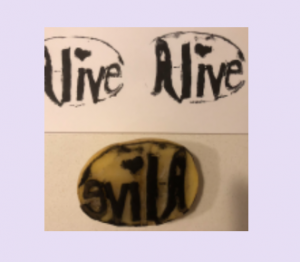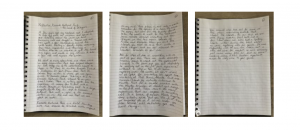For my second linking post submission, I decided to go with Task #4 Manual Script. When I first decided to use this task, I knew that I wanted to choose a task that had been the opposite of mine. With this task we had the option to write a story or journal entry, etc., by hand or we could choose to create a five letter word with a potato stamp. In the beginning I had wanted to try out the potato printing but ended up going with the manual script as I did not think I would have had the patience to create the five letter word. That being said, I wanted to learn more about that experience of potato printing in relation to my manual script and therefore I chose to draw on Katrina Wong’s Task #4 as she went with the potato printing.
My Link: https://blogs.ubc.ca/meipsyshack/2021/02/06/task-4-manual-script/
Katrina’s Link: https://blogs.ubc.ca/katrinawong/4-4-task-4-manual-scripts-and-potato-printing/
I was quite fascinated with Katrina’s process of her potato printing and how she captured the experience through a time-lapse video that she posted in her blog space. Her explanation of the process was interesting given the challenges she encountered with the tools that she used, the planning process and how much time it took to create the stamp of the word “alive.” I liked how she stated that she, “began to understand, with a deep appreciation, just how much skill, time and effort it must have taken for people to letter print several hundreds of years ago.” I could see through her experience how challenging it was to just create that stamp.
As I chose the manual script, my challenges differed from that of Katrina’s. My challenges stemmed more in planning what I wanted to say. Before writing I wanted to think about what I wanted to say and chose my words carefully so that the reader would understand the story that I was trying to depict. I also wanted to try my best to write in my best penmanship in order for the reader to be able to decipher what I was trying to say. I also found that I needed to give my hand a break every once in a while as it began to tire from the act of writing by hand. I can see how difficult it was for Katrina to create that potato stamp and how she had to be careful with creating that five word script so that it would be legible. Both of the literacies, although different, reinforce what Harris (2011) says about, “Cultivating the progress of knowledge in our own time,” and again reinforce how much has changed and advanced with the printed word and how much technology has made just printing the written word that much easier. Although both Katrina and I had chosen a different path for this assignment we both took an approach to understand how text and literacies have changed over the years. This also made me connect with what Katrina was reflecting on with her own observations of the process of creating her word and, “how students are influenced by what they see as text (print). For example, graphic novels with in text all CAPITALS to highlight and enhance words to engage students [and] is this type of text influencing how students hand write and print.” I found this observation of hers to be quite interesting and it made me reflect on how my own students in grade six are influenced by what they see in text. A conversation I will pursue with my students to gain another perspective.
Katrina’s Potato stamp for the word “alive”

My Manual Script

As I explored and navigated through Katrina’s blog site, I found that both of us have quite a similar interface. As I looked closer I could see that we both chose the same theme of BookLite and therefore the layout and the script she used were similar to mine. There are only some slight differences, such as she did have her navigation bar located right at the top of the blog so that you can quickly choose where you wanted to go. This is different from my own as I had a navigation bar that displays under the header picture with drop-downs to allow for choice of where you could go. I also noticed that the header remains the same for each time you click on a different place to go in the site, whereas mine changes. Regardless, I still found her site visually appealing and easy to navigate.
One large drawback however, is that there does not seem to be a place to interact and leave a comment on any of her pages. I know I had a similar issue when I first started to create my blog and through a bit of tweaking I was able to add that feature. Having the ability to be able to interact and leave a comment would allow for a deeper connection to be developed with the person visiting the site in order to develop conversations about the literacies we interact with.
References:
Harris, B. (Producer). (2011, June 11). How it began: A history of the modern world. [Audio podcast] URL https://howitbegan.com/episodes/